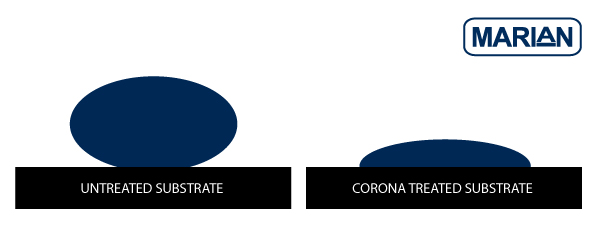Silicone rubber materials and some plastic films have chemically inert and non-porous surfaces, which equates to low surface energy. This means they have a weak molecular bonding force making it difficult to create a bond with many pressure sensitive adhesives.
At Marian, we help our customers by manufacturing custom die-cut silicone sealing gaskets among many other solutions.
Silicone is one of the best gasketing materials for numerous reasons like:
- It operates in the largest temperature range of any elastomer (-100°F to 500°F).
- Silicone is highly resistant to UV, it is odorless, stain resistant, and hypoallergenic.
- It outlasts any other material when it comes to compression set, making it an excellent choice for a long-lasting sealing gasket.
Want to learn more about Silicone? Check out our blog post "Silicone Rubber, a Low Surface Energy Material" where you can download our Free eBook, "Pros and Cons of Designing with Silicone Rubber".
What is Corona Surface Treatment?
Corona surface treatment is a method that increases the surface energy of the treated material by means of “corona discharge plasma”. In simple terms it enhances the surface’s molecular structure to allow improved wettability for the adhesion of inks, coatings and adhesives, and it does this without changes to any other of the physical properties of the material.
The rendering below demonstrates how the surface energy changes after a substrate is corona treated. The surface energy or wettability of the untreated substrate is very low, which is demonstrated by the >90° contact angle. The contact angle of the corona treated surface is <90°, giving it a high surface energy / wettability.

Video Demonstration: Adhesion of Acrylic PSA to Corona Treated and Untreated BISCO HT-870 Soft Silicone Foam
Typically, silicone adhesives readily bond to silicone elastomers without treatments other than cleaning. However, depending on the other surface the silicone elastomer will be bonded, the silicone adhesives may not be able to achieve the strength-of-bond your application requires.
Additionally, silicone adhesives can be 3 to 5 times more expensive that common acrylic PSA. By corona treating, we are able to offer many more options for bonding PSAs and reduce the cost.
In the video demonstration below, we show how 2 different acrylic PSA’s (tesa® 4965 and 3M 9832) bond (or do not bond) to untreated BISCO HT-870 Silicone Foam compared to corona treated BISCO HT-870 Silicone Foam.
Contact Us
Have a project that might require a corona surface treated material? Give us a call or send us a note. One of our sales engineers will respond quickly!



